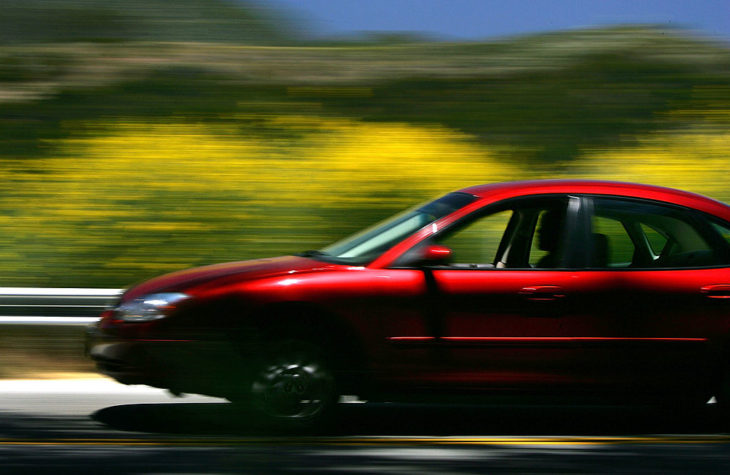
I’m cruising on an uncongested stretch of Interstate 80 when I see an eighteen-wheeler plodding up the hill ahead. I tap my turn signal, glance at my blind spot and coast smoothly into the passing lane. I’m gearing up my vocals for the “got runned over by a damned old trainnnn!” line of David Allan Coe’s song, playing on the radio, when I’m spooked out of my aria by a mid-size SUV barreling down on my bumper like a furious Pamplona bull.
“Cop!” is my first thought, as my pursuer appeared out of nowhere. I let off the gas and check my speed: seventy-nine in a seventy. Too late to tap my brakes. Besides, he’s likely to smash into me if I try that. I rush to merge back into the other lane and await the flashing blue lights.
Except the blue lights never come. The only thing that flashes is a Honda Pilot with standard-issue plates and a sticker denoting the driver once visited Dewey Beach. It blurs by me in the right lane, threading the narrow space separating me and the big rig.
It takes several minutes to recover my driving zen (and find another song worth belting). Even so, I spend the rest of my drive on edge, obsessively checking my rearview mirror for bats out of hell descending as speed demons.
Scenarios like this one play out nearly every time I drive, to the point that an activity I used to find relaxing and enjoyable now makes me anxious. Paranoid, even.
The speeding lunatics-slash-tailgating junkies have put the “get out of my way, or else!” fear into my heart so effectively that I actually obey them. And I say this as a driver with a turbocharged rally car and a portfolio of speeding tickets to match.
There are also the pointless passers — those road warriors who see the slightest break in traffic as cause to put everyone’s life at risk by nipping around the vehicle they’re following. Never mind that there’s a hill ahead, it’s a double-yellow no-passing zone and there isn’t room ahead of the car they’re passing to pull back in again. Or that passing will shave off — five seconds, maybe? “My time’s more important than yours!” these drivers rave in their erratic maneuvers.
Ever have the nerve to look at the driver beside you? The ones driving tractor-trailers are my favorite. They’re able to command 80,000 pounds of goods and machinery while watching — or, better yet, posting — TikTok videos. Their brothers-in-arms (hands?) do their part by missing green lights and sitting for ten extra safe seconds at stop signs, warranting a wake-up honk.
It appears many drivers are auditioning for the next Fast & Furious film while simultaneously being less cognizant of their surroundings than Joe Biden. I’ve come to approach every intersection as a probable T-bone smash zone and, hugging the white line, to view every vehicle opposite me as a likely head-on collision.
I have no confidence fellow drivers will stop when they’re supposed to, turn where their signals indicate, or maintain their lanes. Have you noticed how frequently people drift over the lane markings, only to give the steering wheel a jerky correction when their car’s “lane departure assist” tells them to?
It’s not my imagination: a May 2022 National Highway Traffic Safety Administration report said “traffic fatalities reached a sixteen-year high in 2021.” Transportation secretary Pete Buttigieg called the trend a “crisis on America’s roadways.”
The NHTSA’s solution involves putting billions toward an infrastructure program, “Click It or Ticket” campaigns, and funding to “focus on… safety concerns among vulnerable road users and overrepresented populations.” Mumbo-jumbo aside, I don’t think it’s the roads that are the problem. They need steady maintenance and improvements, sure, but I haven’t noticed them turning into rubbly sinkhole strips à la the Republic of Chad.
I reckon the real reason there are so many more roadway fatalities of late is because the number of aggressive, zoned-out and distracted drivers increased immensely since the outbreak of Covid.
The mental health damage done by excessive screen time during lockdown is well documented, as is the association between technology’s stimulation and immediate gratification, and decreased attention spans and focus. The urgency of our news cycles and online society surely don’t help. Neither does the false confidence our vehicles’ “collision prevention safety features” impart.
At the height of Covid, prescriptions for anti-anxiety medication increased 34 percent. A common side-effect of these medications is something called “emotional blunting,” in which, according to Healthline, users experience “limited emotional reactivity.” One law firm website I came across warns clients: “Taking medication for anxiety? You could be driving impaired.”
Throw into this mix of real-life Mario Karters the growing number of drivers who are Dazed and Confused. Weed is now more popular than cigarettes, a growing number of Americans smoke marijuana regularly, and the cannabis-infused products market is exploding.
It’s as if people believe they’re living in virtual reality and drive accordingly, in a super-hurry and indifferent to danger. And if you feel as if the driving public is increasingly unsafe, you’re not alone. I’m right there with you.
Except not really. I’m at home, forgoing anxiety and anti-anxiety meds and anti anxiety weed by avoiding the anxiety-ridden roads.
This article was originally published in The Spectator’s February 2023 World edition.
The post Why after Covid does everyone drive like maniacs? appeared first on The Spectator World.
via IFTTT
InoreaderURL: SECONDARY LINK
